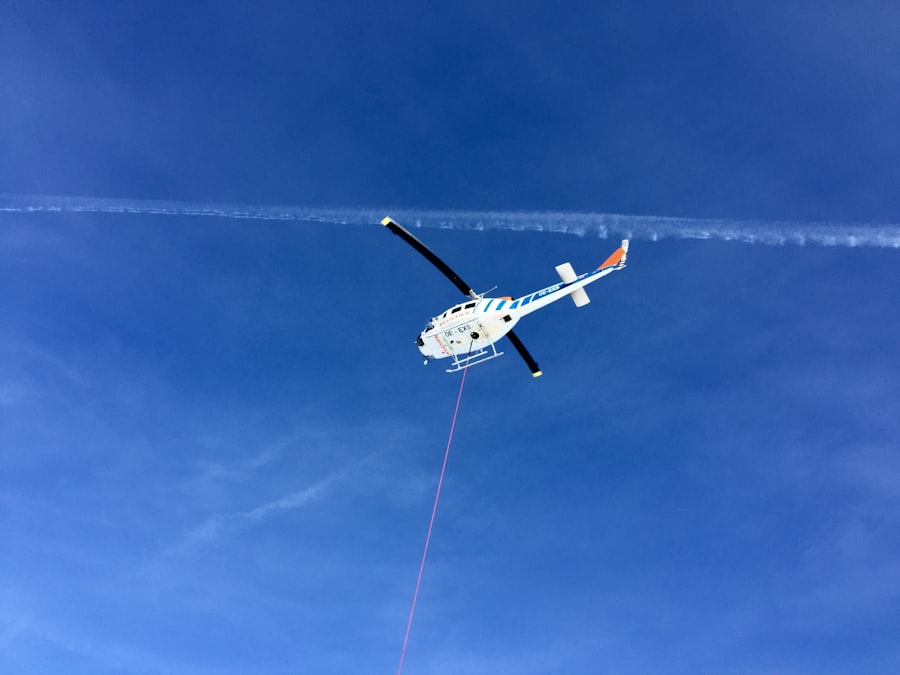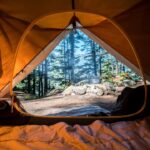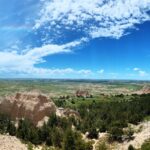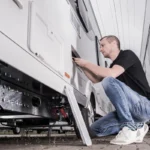Overlanding is a form of travel that has gained immense popularity in recent years. It involves exploring remote and off-the-beaten-path destinations using a vehicle, typically a 4×4 or an adventure motorcycle. Overlanding allows travelers to immerse themselves in nature, disconnect from technology, and challenge themselves physically and mentally. In this article, we will delve into the benefits of exploring the road less traveled, provide tips and tricks for planning an overlanding adventure, discuss essential gear and equipment, offer a comprehensive guide to finding the best overlanding trails, explore safety considerations when venturing into remote destinations, examine the pros and cons of traveling with a group, discuss the environmental impact of overlanding and how to minimize it, share stories from experienced overlanders about overcoming challenges, and reflect on the life lessons and takeaways from an overlanding adventure.
The Benefits of Exploring the Road Less Traveled
One of the main benefits of overlanding is the freedom it offers to explore off the beaten path. Unlike traditional forms of travel where tourists are confined to popular tourist destinations, overlanding allows travelers to venture into remote areas that are often untouched by mass tourism. This sense of freedom and exploration can lead to unique and authentic experiences that are not easily replicated.
Another benefit of overlanding is the opportunity to disconnect from technology and connect with nature. In today’s digital age, many people are constantly connected to their devices, which can be overwhelming and exhausting. Overlanding provides a chance to escape from this constant connectivity and immerse oneself in the natural world. Spending time in nature has been proven to reduce stress levels, improve mental health, and increase overall well-being.
Furthermore, overlanding allows individuals to challenge themselves physically and mentally. Navigating through rugged terrain, setting up camp in remote locations, and overcoming unexpected obstacles require problem-solving skills, adaptability, and resilience. By pushing oneself outside of their comfort zone, overlanders can develop these qualities and gain a sense of accomplishment and self-confidence.
Planning Your Overlanding Adventure: Tips and Tricks
Before embarking on an overlanding adventure, it is important to thoroughly research and select a destination that aligns with your interests and skill level. Consider factors such as the terrain, weather conditions, and availability of resources. It is also essential to check for any permits or regulations that may be required for certain areas.
Preparing your vehicle for the journey is crucial to ensure a safe and successful overlanding experience. This may involve making modifications to your vehicle, such as installing off-road tires, a roof rack, or a winch. Regular maintenance checks should also be conducted to ensure that your vehicle is in optimal condition.
When packing for an overlanding trip, it is important to prioritize safety and comfort. Essential items include a first aid kit, emergency supplies such as food and water, navigation tools, communication devices, camping gear, and clothing suitable for various weather conditions. It is also advisable to pack light and only bring what is necessary to avoid overloading your vehicle.
Creating a flexible itinerary is key to enjoying the spontaneity and freedom that overlanding offers. While it is important to have a general plan in place, leave room for unexpected detours or changes in route. This flexibility allows for serendipitous discoveries and the ability to adapt to unforeseen circumstances.
Essential Gear and Equipment for Overlanding
| Essential Gear and Equipment for Overlanding | Description |
|---|---|
| Tent | A shelter for sleeping and protection from the elements. |
| Sleeping bag | A warm and comfortable bag for sleeping in. |
| Camp stove | A portable stove for cooking meals. |
| Cooler | A container for keeping food and drinks cold. |
| Water filter | A device for filtering water from natural sources. |
| First aid kit | A kit containing medical supplies for emergencies. |
| Navigation tools | Maps, compass, and GPS for finding your way. |
| Recovery gear | Winch, tow straps, and shackles for getting unstuck. |
| Communication devices | Radio, satellite phone, or cell phone for emergency communication. |
| Tools | Basic tools for vehicle and equipment repairs. |
When it comes to overlanding, having the right gear and equipment can make all the difference. Vehicle modifications are often necessary to ensure that your vehicle can handle the demands of off-road travel. This may include installing a lift kit, upgrading suspension components, or adding skid plates for added protection.
Camping gear and supplies are essential for overnight stays in remote locations. A sturdy tent, sleeping bags, cooking equipment, and portable toilets are just a few examples of the gear needed for a comfortable camping experience. It is important to invest in high-quality gear that is durable and can withstand the rigors of overlanding.
Navigation tools and communication devices are crucial for staying on track and ensuring safety. GPS devices, maps, and compasses are essential for navigating through unfamiliar terrain. Additionally, having a reliable communication device such as a satellite phone or a two-way radio can be a lifesaver in case of emergencies or when traveling in areas with limited cell phone coverage.
Emergency equipment and first aid kits are vital for handling unexpected situations. A well-stocked first aid kit should include basic medical supplies such as bandages, antiseptics, and pain relievers. Other emergency equipment may include fire extinguishers, recovery gear such as tow straps and shackles, and tools for basic vehicle repairs.
Finding the Best Overlanding Trails: A Comprehensive Guide
When it comes to finding the best overlanding trails, thorough research is key. Consider factors such as the difficulty level, terrain type, and length of the trail. Online forums, guidebooks, and social media groups dedicated to overlanding can be valuable resources for finding recommendations and firsthand experiences from other overlanders.
It is important to consider the season and weather conditions when selecting a trail. Some trails may be impassable during certain times of the year due to snow, flooding, or extreme heat. Researching the weather patterns and seasonal variations in your chosen destination will help you plan your trip accordingly.
Checking for permits and regulations is essential to ensure that you are in compliance with local laws and regulations. Some areas may require permits for camping or off-road travel, while others may have restrictions on vehicle size or weight. It is important to obtain any necessary permits in advance to avoid any legal issues during your trip.
Seeking recommendations from experienced overlanders can provide valuable insights into the best trails and destinations. Joining overlanding communities, attending meetups or events, and connecting with experienced overlanders through social media platforms can help you tap into a wealth of knowledge and expertise.
Exploring Remote Destinations: Safety Considerations

When venturing into remote destinations, it is important to be prepared for emergencies and unexpected situations. This includes having a plan in place for communication, navigation, and emergency response. Informing loved ones or trusted individuals about your travel plans and itinerary is crucial so that they can be alerted in case of an emergency.
Understanding the risks of wildlife encounters is important when exploring remote areas. Research the local wildlife and their behavior to ensure that you are prepared to handle any encounters safely. This may involve carrying bear spray or other deterrents, practicing proper food storage techniques, and knowing how to react in the presence of wildlife.
Staying aware of weather conditions and natural hazards is essential for staying safe while overlanding. Research the local climate and weather patterns to anticipate any potential hazards such as flash floods, landslides, or extreme weather events. It is important to have a backup plan in case of inclement weather or unsafe conditions.
Communicating with loved ones and emergency services is crucial for maintaining safety while overlanding. Ensure that you have reliable communication devices such as a satellite phone or a two-way radio that can be used to call for help in case of emergencies. Familiarize yourself with emergency contact numbers and protocols for the areas you will be traveling in.
Overlanding with a Group: Pros and Cons
Traveling with a group can have numerous benefits when it comes to overlanding. One of the main advantages is the increased safety and security that comes with having multiple people around. In case of emergencies or unexpected situations, having a group can provide additional support and resources.
Another benefit of traveling with a group is the shared experiences and camaraderie that comes with it. Overlanding can be a challenging and rewarding experience, and having a group to share those experiences with can enhance the overall enjoyment of the trip. It also provides an opportunity to learn from others and gain new perspectives.
However, there are also challenges that come with group overlanding. Group dynamics and decision-making can sometimes be difficult, especially when there are varying opinions and preferences. It is important to establish clear communication and decision-making processes within the group to ensure that everyone’s needs and concerns are addressed.
Tips for successful group overlanding include setting clear expectations and goals from the beginning, establishing a leader or designated decision-maker, and maintaining open and honest communication throughout the trip. It is also important to be flexible and adaptable, as unexpected situations may arise that require changes in plans or routes.
The Environmental Impact of Overlanding: How to Minimize Your Footprint
While overlanding allows travelers to explore remote and untouched areas, it is important to be mindful of the environmental impact it can have. Off-road travel can cause damage to fragile ecosystems, contribute to soil erosion, and disturb wildlife habitats. It is crucial to practice responsible overlanding and minimize your footprint as much as possible.
Understanding the impact of overlanding on the environment is the first step in minimizing it. Educate yourself about the local flora and fauna, fragile ecosystems, and conservation efforts in the areas you will be traveling in. This knowledge will help you make informed decisions and take actions that minimize your impact.
Practicing Leave No Trace principles is essential for responsible overlanding. This includes packing out all trash, disposing of waste properly, minimizing campfire impacts, respecting wildlife and their habitats, staying on designated trails, and leaving natural and cultural artifacts undisturbed. By following these principles, you can ensure that future generations can enjoy these remote destinations as well.
Choosing eco-friendly gear and equipment is another way to minimize your environmental impact while overlanding. Opt for gear made from sustainable materials, such as recycled or organic fabrics. Consider the energy efficiency and environmental impact of any electronic devices or appliances you bring along.
Supporting conservation efforts and responsible tourism is crucial for preserving the natural beauty and biodiversity of the areas you visit. Research and support local organizations and initiatives that are dedicated to protecting the environment and promoting sustainable tourism practices. By contributing to these efforts, you can help ensure that these remote destinations remain pristine for future generations to enjoy.
Overcoming Challenges on the Road Less Traveled: Stories from Experienced Overlanders
Overlanding is not without its challenges, and experienced overlanders have countless stories of overcoming obstacles and difficult situations. These stories serve as valuable lessons and reminders of the resilience, adaptability, and problem-solving skills that are developed through overlanding.
One common challenge faced by overlanders is vehicle breakdowns or mechanical issues. Being prepared with basic vehicle repair knowledge and having the necessary tools and spare parts can help overcome these challenges. Additionally, having a backup plan or alternative transportation options can be useful in case of major breakdowns.
Navigating through difficult terrain is another challenge that overlanders often face. This may involve crossing rivers, traversing steep inclines or descents, or maneuvering through narrow trails. Proper training, experience, and knowledge of off-road driving techniques can help overcome these challenges safely.
Unpredictable weather conditions can also pose challenges while overlanding. From sudden storms to extreme heat or cold, being prepared with appropriate clothing, gear, and emergency supplies is crucial. It is important to stay informed about weather forecasts and be ready to adapt plans if necessary.
Despite these challenges, experienced overlanders often emphasize the importance of staying positive and resilient on the road less traveled. Maintaining a positive mindset, being adaptable to changing circumstances, and embracing the unexpected can turn challenges into opportunities for growth and self-discovery.
Making the Most of Your Overlanding Adventure: Life Lessons and Takeaways
An overlanding adventure is not just about the destinations and experiences, but also about the personal growth and self-discovery that comes with it. Overlanding teaches valuable life lessons and provides opportunities to develop qualities such as resilience, adaptability, and problem-solving skills.
Reflecting on personal growth and self-discovery is an important part of the overlanding experience. Take time to appreciate the challenges you have overcome, the new skills you have acquired, and the personal strengths you have discovered. These reflections can help you gain a deeper understanding of yourself and your capabilities.
Lessons learned from overlanding can be applied to everyday life. The resilience and adaptability developed through overlanding can help navigate challenges in various aspects of life. The problem-solving skills honed on the road less traveled can be applied to work, relationships, and personal goals.
Tips for incorporating the lessons learned from overlanding into everyday life include setting goals that push you outside of your comfort zone, embracing change and uncertainty, and maintaining a positive mindset in the face of challenges. Remember that the skills and qualities developed through overlanding are transferable to all areas of life.
Overlanding offers a unique and rewarding way to explore the road less traveled. The benefits of overlanding include the freedom to explore off the beaten path, the opportunity to disconnect from technology and connect with nature, and the chance to challenge oneself and build resilience. Planning an overlanding adventure involves researching and selecting a destination, preparing your vehicle, packing essentials for safety and comfort, and creating a flexible itinerary. Essential gear and equipment for overlanding include vehicle modifications, camping gear, navigation tools, and emergency equipment. Finding the best overlanding trails requires researching difficulty levels, considering weather conditions, checking for permits, and seeking recommendations from experienced overlanders. Exploring remote destinations requires safety considerations such as preparing for emergencies, understanding wildlife risks, staying aware of weather conditions, and communicating with loved ones and emergency services. Overlanding with a group has its pros and cons, and successful group overlanding requires clear expectations, communication, and decision-making processes. The environmental impact of overlanding can be minimized by understanding the impact, practicing Leave No Trace principles, choosing eco-friendly gear, and supporting conservation efforts. Overcoming challenges on the road less traveled is a common experience for overlanders, and stories from experienced overlanders serve as valuable lessons in resilience and problem-solving. Making the most of an overlanding adventure involves reflecting on personal growth and self-discovery, applying lessons learned to everyday life, and embracing the qualities developed through overlanding. In conclusion, overlanding offers a unique and rewarding way to explore the world and oneself, and it is an adventure worth embarking on.
If you’re looking for some exciting overlanding trails to explore, check out this article on “Arizona’s Best Overlanding Destinations: Exploring the Wild West.” It provides a comprehensive guide to the top off-road routes in Arizona, complete with stunning landscapes, historical sites, and camping spots. Whether you’re a seasoned overlander or just starting out, this article will help you plan your next adventure. Click here to read more about it.
FAQs
What is overlanding?
Overlanding is a type of self-reliant travel where the journey is the primary goal, often involving off-road vehicles and camping equipment to explore remote and rugged terrain.
What are overlanding trails?
Overlanding trails are routes or paths that are specifically designed for overlanding vehicles to explore and navigate through. These trails can range from easy to difficult and can be found in various locations around the world.
How do I find overlanding trails?
There are several ways to find overlanding trails, including researching online, joining overlanding groups or forums, consulting with local off-road clubs, and using GPS or mapping apps.
What should I consider when choosing an overlanding trail?
When choosing an overlanding trail, consider the difficulty level, the length of the trail, the terrain, the weather conditions, and the availability of resources such as fuel, water, and food.
What equipment do I need for overlanding?
The equipment needed for overlanding varies depending on the trail and the vehicle being used, but typically includes a reliable off-road vehicle, camping gear, navigation tools, recovery equipment, and emergency supplies.
What are some popular overlanding trails?
Some popular overlanding trails include the Trans-America Trail in the United States, the Pan-American Highway in North and South America, the Silk Road in Asia, and the Australian Outback.










